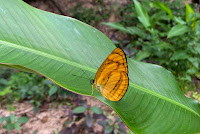<> Pantoporia paraka (Butler,[1879]) <>
the Perak Lascar ผีเสื้อกะลาสีแดงเปรัค
Click on any photo to see larger version

Photo taken at Doi Suthep-Pui National Park, Chiang Mai, Thailand. 1050m a.s.l.

Quite widely distributed across the region except in the coldest countries, Nepal and Bhutan. It can be locally common. There is little difference between the sexes and they look similar to each other. Although basically a forest species, where it prefers to stay, it is often seen at forest edges and in sunny glades within the forest. It is a fairly weak flier and usually flies close to the ground. Multivoltine with several broods per annum.
Synonyms and previously used names: Rahinda paraka, Neptis paraka
Taxonomy: Animalia - Arthropoda - Insecta - Lepidoptera - Nymphalidae - Limenitidinae - Pantoporia - paraka
Regional Distribution: India, Bangladesh, Myanmar, Thailand, Laos, Cambodia, Vietnam, China, Malaysia, Singapore, Indonesia, Philippines
Habitat: low altitude forest, up to 1000m a.s.l. Wingspan: 38-45mm
Flight time: most of the year, depending on location
Life History: egg 3 days instar 1 2 days instar 2 3 days instar 3 6-8 days instar 4 8-9 days instar 5 10-18 days pupa 6-7 days Total egg to adult 38-50 days. All times approximate.
Larval Hosts: Albizia corniculata, Archidendron clypearia, Dalbergia candenatensis, Dalbergia rostrata (Fabaceae), Cnestis palala (Connaraceae). Hosts used depends upon location and availability of plant species.
Adult Food Sources: Nectar - is known to occasionally visit flowers but as yet none have been recorded. Other - mud puddling
Links to other pages in this series for species in the same subfamily
Athyma perius
Auzakia danava
Euthalia alpheda
Euthalia lubentina
Lasippa viraja
Limenitis asura
Neptis cartica
Neptis miah
Pantoporia hordonia
Sumalia daraxa
Athyma pravara
Bhagadatta austenia
Euthalia anosia
Euthalia monina
Lebadea martha
Limenitis dudu
Neptis clinia
Neptis nashona
Pantoporia paraka
Sumalia zulema



